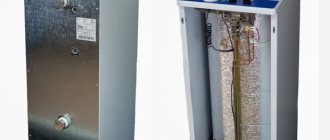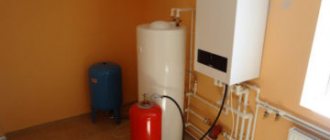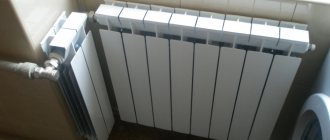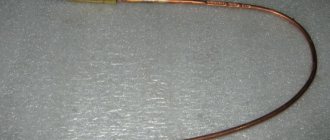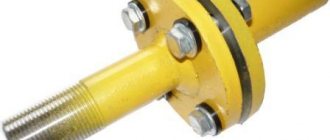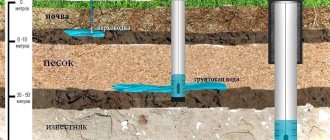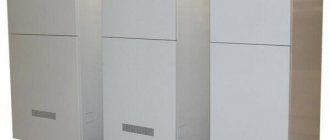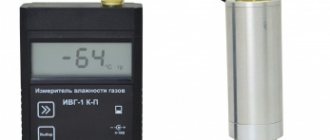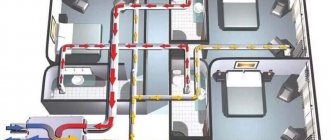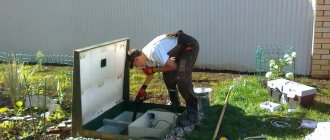How to choose?
What you need to pay attention to when choosing a burner device for a boiler:
- productive power - noise level during operation (applies to supercharged models) - type of heating equipment for which the burner is purchased - type of fuel - pros and cons of this device - provide for possible malfunctions in the operation of the local gas supply line.
Taking these factors into account, you can choose the most suitable burner device for your boiler so that it operates as efficiently as possible without the burden of frequent preventative maintenance.
Automatic welding – who controls the quality?
During automatic welding, special devices carry out the process and control the quality of the connection, because welding is performed once, and defects are very clearly visible, so it is important to prevent their formation. The undoubted advantage of this type of welding is that it eliminates the presence of a welder during the process. In addition, the advantages are good seam quality and a minimum of effort. The only negative is the large initial investment.
The main feature of the automatic method is that the arc burns under a dense layer of flux. Liquid flux forms a bubble around the arc filled with chemical gases that are released during the combustion process. The use of flux is mandatory for welding; it improves the quality of the seam. During operation, when the base metal is melted, the arc throws it back, thereby forming a depression, which is then filled with a new layer of molten metal.
- Author: Mikhail Malofeev
Rate this article:
- 5
- 4
- 3
- 2
- 1
(1 vote, average: 5 out of 5)
Share with your friends!
Combustion chamber of heating equipment
Gas boilers differ primarily in the design of the combustion chamber. It comes in two types:
- open;
- closed.
The open chamber is a fairly simple combustion device. It looks like this: above the burner there is a heat exchanger in the form of a coil of thin copper tubes. Thanks to the open design, the air required for the combustion reaction is supplied to the point of ignition of the gas from the environment.
As a rule, there is enough air from the room (provided good ventilation is organized). But there are wall-mounted models with air intake from outside, for which a special hole is mounted in the wall. Open combustion chambers require a chimney.
Most often it is installed for models of floor-standing gas boilers, and was also used to complete an old-style boiler (in this case, ignition was carried out by a pilot burner).
Combustion chamber design diagrams
The closed combustion chamber is distinguished by the design of the heating block. The heat exchanger is located above the burner. The unit body is closed, combustion air is pumped by a fan installed in the chamber. Coolant is passed through the double walls of the chamber, heating it, increasing the efficiency of the boiler. The gas is burned almost completely, the combustion products are removed by a coaxial pipe under air pressure.
Rules for inclusion and operation
You can light the oven in a gas stove manually or using an electric igniter (automatic or semi-automatic).
Manual activation
Modern mid-price models (for example, Nord, DARINA, Gefest 3200-05) are equipped with only the necessary functions without frills. Switching on occurs through mechanical rotary switches, there is often an audible timer, convenient for the cooking process, and a gas control function, which serves to turn off the gas supply if the flame goes out. But you need to ignite the gas-air mixture in the traditional way (with matches, a piezo lighter, etc.).
To turn on a gas oven manually, you need to open the door, hold a burning match to the igniter hole, press and turn the mechanical switch to the maximum flame position. The handle should be pressed for 10 seconds to ensure gas flow and ignition. When the thermocouple heats up, the safety valve will turn off. Then, after making sure that the fire is burning, you can use the oven for its intended purpose.
Electric ignition
Modern stove models (for example, Indezit, Greta) often have both basic functions and additional ones. They are equipped with a timer, bright lighting, a gas control system and an electric igniter. This function involves lighting a fire in a gas burner using an electric spark without opening the oven door.
Important! Electric ignition of the oven can be automatic (by turning the gas regulator) or semi-automatic (by additionally pressing a separate button).
To turn on ovens that have an electric ignition function, you need to perform the following steps:
- use the fire regulator to set the maximum mode, thus starting the gas supply;
- press the electric ignition button;
- make sure there is fire and release the button (after about 5-10 seconds).
You should know that the electric ignition button must not be held down for more than 15 seconds. If the burner does not light during this time, it would be correct to open the oven and ventilate for a minute, then try again .
How to turn on the grill
Modern models of luxury ovens are equipped with a gas grill function. To turn it on, you just need to bring the fire (a burning match, a lighter) to the top burner of the oven and turn the corresponding gas regulator clockwise until it stops.
Types of burners
According to their design and functional differences, burner devices are divided into:
By purpose:
- for high power industrial equipment
- for household equipment.
By fuel type used:
- devices for natural gas;
- devices for liquefied gas;
- universal devices.
By flame adjustment:
- single-stage – capable of operating on/off;
- two-stage (as a variation - models with smooth modulation) - operate at full power, when the desired temperature is reached, the flame is reduced by half;
- modulating - boilers with a modulating burner are characterized by smooth adjustment of the flame power.
According to the operating principle:
- injection/atmospheric. They operate by supplying air from the room. They are installed respectively in open combustion chambers. Also used for old-style boiler models.
- fan/supercharged. They work in isolated combustion chambers. Combustion air is supplied by a fan. According to their design features, they are divided into: - vortex (round-shaped nozzle holes) - direct-flow (shape of a narrow slot with a round/rectangular cross-section).
- diffuse-kenetic. Air enters two simultaneously: one is mixed with gas fuel, the second is added directly to the chamber during combustion.
Main characteristics
If you want to purchase this equipment, then you need to know which parameters play the main role.
- Flame type. The flame may resemble a torch or be a swirl type. For spot soldering, a flame in the form of a torch is suitable. This will allow you to influence a small area of the product. But the vortex flame warms up a large surface area well.
- Flame adjustment. Some types of burners do not have a regulator at all. On the rest it is located in different places. The simpler the fire adjustment, the more convenient the work. The variety of positions of the regulator will allow you to process different materials and perform other operations in addition to soldering - metal tempering, heating and others.
Devices with disposable and stationary cylinders
The most convenient and compact device is a mini-gas burner, which is equipped with a disposable cylinder. It is good to use for soldering copper products in hard-to-reach places, and its low weight and compactness make the work more convenient. The fuel in such burners is gas mixtures, acetylene or propane. On the handle of the device there is a valve for adjusting the fire level.
Maximum connection quality can be achieved by using gas burners with stationary cylinders. With their help, you can process even the most refractory metals.
Gas burner device for a boiler
Atmospheric and fan burner devices differ in their structure. This is due to the different ways in which oxygen is supplied to the chamber during fuel combustion.
Atmospheric burner device.
Air enters the combustion chamber directly from the room. Nozzles are located inside the burner channel. Gas is supplied to the nozzles, mixing with air, which also has access here. At a short distance from the nozzles there are outlet slots through which the finished fuel mixture is supplied. An area of reduced pressure is created between the nozzles and outlets, which promotes a constant supply of air for mixing.
A pilot burner is constantly running in the combustion chamber to ignite the main device.
Fan burner device.
The device block consists of:
- engine;
- fan;
- automatic control unit;
- gearbox;
- air pressure switch;
- fuel mixer.
Air is forced from outside by a fan and supplied to the combustion chamber to form a fuel substance. The air to gas ratio can be adjusted using a damper and a fan.
Turning on the oven
The procedure for igniting the burner inside the oven is more complicated than on the surface of the stove. Often the view is blocked by a massive tray, and it is suggested to use only a small hole with access to the burner. This not only makes it difficult to start, but also makes it difficult to see whether the torches in the holes in the round base are fully lit.
The safest way is the auto-ignition built in by the manufacturer, which provides a stable spark for the flame. The second highest risk are electric or pneumatic lighters with an elongated bell for supplying a spark. They protect the owner's hands from accidental burns in case of fire. The most dangerous methods include outdated wooden matches or a piece of paper rolled up into a ball.
You can light the oven with matches or a lighter, but it is safer to use automatic ignition.
Before turning on the new oven, it must be wiped down and dried. If the stove has already been used, it is important to completely clean the internal surfaces of burnt food residues so that additional combustion of carcinogenic substances does not occur when heat is supplied.
When starting the heating, you need to take into account the built-in flame control mechanism, holding the knob for at least three seconds so that it does not go out.
Burner flame
One of the indicators of proper burner operation is the color of the flame. Gas equipment is characterized by an even bluish flame without admixtures of other colors. The presence of yellow or red splashes indicates that the burner is not working well, which reduces the efficiency of the heating equipment.
First of all, this applies to injection burner devices, but sometimes it is also typical for fan burners. The flame may simply lack oxygen. Also, dust and other small debris can get in with the air, which will clog the device, reducing the efficiency of the boiler. All this directly affects the flame. If it hums, the burner is loud, or the fire has changed color, you need to adjust the correct operation of the device.
Choosing gas
You can only make a gas burner using propane, butane or a propane-butane mixture with your own hands, i.e. on gaseous saturated hydrocarbons and atmospheric air. When using 100% isobutane (see below), it is possible to achieve flame temperatures of up to 2000 degrees.
Acetylene allows you to achieve a flame temperature of up to 3000 degrees, but due to its danger, the high cost of calcium carbide and the need for pure oxygen as an oxidizing agent, it has practically fallen out of use in welding work. It is possible to obtain pure hydrogen at home; a hydrogen flame from a supercharged burner (see below) gives temperatures up to 2500 degrees. But the raw materials for producing hydrogen are expensive and unsafe (one of the components is a strong acid), but the main thing is that hydrogen cannot be smelled or tasted, there is no point in adding a mercaptan fragrance to it, because Hydrogen spreads an order of magnitude faster, and its admixture with air of only 4% already produces an explosive explosive gas, and its ignition can occur simply in the light.
Methane is not used in household gas burners for similar reasons; in addition, it is highly poisonous. As for flammable liquid vapors, pyrolysis gases and biogas, when burned in gas burners they produce a not very clean flame with a temperature below 1100 degrees. Flammable liquids of medium and below average volatility (from gasoline to fuel oil) are burned in special liquid burners, for example, in burners for diesel fuel; alcohols are used in low-power flame devices, and ethers do not burn at all - they have low energy, but are very dangerous.
In what cases is it necessary to adjust the burner flame?
An atmospheric gas burner for heating equipment often fails. It is equipped with models of both wall-mounted and floor-standing boilers. The injection burner of floor-standing equipment reduces its efficiency for various reasons:
- Burner power is too high. This happens when a high-power burner is purchased for small heating equipment. At the same time, there is not enough space for combustion, the air flow for such power is weak, which leads to the transition of the flame from blue to yellow, sooting of the combustion chamber and chimney.
- If the chimney is poorly cleaned, the boiler draft deteriorates. At the same time, waste combustion products are poorly removed, and the air flow is small. This worsens combustion and the flame turns yellow.
- A defect in the burner itself does not make it possible to correctly adjust the complete combustion of the fuel.
- Due to pressure changes in the gas supply system, well-regulated equipment can release large amounts of unexhausted gas into the chimney. Partially it settles with soot and soot. A large layer of soot reduces traction and increases fuel consumption.
- Starting heating equipment after repair.
- The presence of extraneous noise during operation of the boiler or gas burner.
- Changing the type of fuel.
You may be interested in learning about the operating principle of a double-circuit gas boiler >>>
Features of choosing a compact device
Before buying a gas burner, you need to decide on its purpose - for repairs, soldering parts, tourism, cooking. The choice of model depends on the tasks that the device will have to cope with
And here it is important to understand the differences between burner types
Varieties of popular devices
There are 4 main designs: “lighters” screwed onto a cylinder, with a fuel hose, blowtorches. There are also integrated cooking systems, but they are difficult to classify as mini. These devices are large in size and weight, expensive, and can only be used with original cookware.
Type #1 – portable torch lighter
The smallest “lighters” are convenient for household purposes and minor repairs. Some models produce more power and can be used for soldering.
Type #2 – balloon type mini-burner
Compact cylinder burners are convenient and light in weight - most devices fit in your hand and fall in the weight range of 70-90 g. They are easy to use, inexpensive, and relatively reliable.
The cylinder itself cannot be forcibly heated, so such burners are not entirely suitable for use in difficult weather conditions.
Another nuance is that the lightness of the design does not allow you to place large-capacity dishes (from 3 liters) on it. But for some models branded adapters are sold: hoses, additional legs.
The rating of the best gas burners for a can is presented in this review.
Type #3 – device with remote hose
But devices with a hose perform well in bad weather conditions. You can place bulky or heavy dishes on them. Fuel consumption in such burners is minimal.
A continuous wind shield can be installed around the burner with a hose, which will increase work efficiency. The design itself is distinguished by the wide setting of the legs and squatness. The permissible volume of dishes is up to 8 liters.
Often in such devices the nozzle itself is larger than that of the bulbs. Due to this, the dishes are heated evenly, and the flame power is conveniently regulated. The burner allows you not only to heat water, but also to fry and stew food.
Devices with a hose also have their disadvantages. They are heavier and larger in size. The hose requires careful operation; the part may break and lead to a gas leak.
Type #4 – blowtorch
Portable blowtorches are designed for the application of machining connections made of ferrous and non-ferrous metals. They are found in piping systems, electrical appliances, cables, and car parts. These also include torches for soldering copper pipes.
The characteristics indicate the flame temperature and power. A device whose flame heats up to 1200-1500°C can cope with parts up to 3 mm thick. A power of 2-3 kW is enough to heat and bend reinforcement up to 14 mm.
The scope of application of such devices is not limited to soldering. They do an excellent job of lighting a fire, working in a summer cottage (removing leaves, getting rid of insect colonies), wood burning, and culinary experiments.
Method of connection to the cylinder used
Most models on the market are adapted for threaded cylinders. But purchasing them in remote settlements is problematic.
If the hike will take place in such areas, you need to very accurately calculate the required amount of gas or additionally buy an adapter for a collet one.
Collet cylinders are also called “dichlorphos”. They are sold at almost any hardware store. But the seam design is less reliable, and the gas mixture is sensitive to low temperatures.
There is also a third type of cylinders on the Russian market - without threads with a bayonet mount. But they are represented only by the Campingaz brand and are not as widespread as abroad.
There are models adapted for use in conjunction with a threaded and bayonet standard.
Additional device options
The presence of piezo ignition is a useful addition, but it is still worth having a backup fire source with you. For some models, this element quickly becomes unusable.
If your camping burner is missing a grate, a protective cover on your computer fan can easily replace it. It is lightweight and does the job perfectly.
When choosing a device for delicate work, welding, soldering, you should pay attention to the ergonomics and balancing of the model. The shape of the body and the arrangement of the elements matter, because the burner will have to be turned on and off frequently. It’s convenient if you can do it with one hand
It is convenient if this can be done with one hand.
Equipment setup
Floor-standing gas boilers with an atmospheric burner can be configured independently. Pressurized systems are regulated by an automatic control unit and do not require additional configuration.
Scheme of actions for setting up single-stage equipment:
- Install the device on the boiler.
- Connect to the gas pipe.
- Check for absolute tightness.
- Remove the burner housing.
- Using a pressure gauge, measure the gas pressure at the inlet.
- Connect to electricity. Make sure that the jumpers and phases are connected correctly.
- Place a gas analyzer in the chimney pipe.
- Start the device.
- Using a pressure gauge, take pressure readings at the outlet of the burner block. Pressure readings must correspond to the parameters indicated in the data sheet.
- Adjust the air flow using the air damper.
- The gas analyzer readings must also comply with all gas equipment installation standards.
Setting up gas equipment should be carried out by specialists. The simplest open-type boilers can be configured independently if you have certain skills and knowledge of the design of the burner unit. The efficiency of the boiler, its level of efficiency, and fuel consumption depend on the quality of the burner. It is possible to superficially determine that the equipment is malfunctioning by the changed burner flame.
Precautions for use
A gas stove and oven are household appliances for cooking food and heating water. Moreover, a baking sheet or rack in the oven cannot be loaded with a mass of more than 6 kilograms. It is prohibited to use the device for purposes other than its intended purpose, that is, for drying wet things or heating a room. This device can be used by people who do not have physical or mental disabilities. Small children should not be allowed to play near a hot oven. The stove must be placed in a safe place in case of fire. It is usually installed on the floor. Ventilation must be provided in the room where these household appliances are located.
The oven must not be left unattended. A person should always control the cooking process. If you notice the smell of gas in the room, you must immediately turn off the gaseous fuel supply valve and turn all flame regulators to the starting position. At the time of an accident, you must immediately open the window in the kitchen and call the emergency service. In the event of a gas leak, it is prohibited to light matches, smoke indoors, or turn on electricity or household appliances. Any spark can cause a fire.


